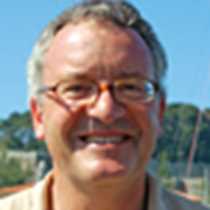Iona
In perfect midsummer light, we loosed our moorings at the pierhead in Oban at the start of breakfast to make for the Isle of Mull at Craignure, passing between a splendid example of a Stephenson lighthouse to starboard and the romantic archetypical Scottish castle of Duart to starboard en route.
Our destination for today, as it has been for countless thousands of pilgrims over the unfolding centuries, was the holy island of Iona, a cradle of Christianity for mediaeval Europe. Columba arrived here from Donegal in Ireland in 563AD, possibly a refugee in time of civil strife – he is said to have a scar on his face, so perhaps he had been an active participant? Another possibility is that he was in disgrace from a legal ruling made against him after he had retained the copy of a manuscript he had been given to copy: “To each cow its calf, to every book its copy” was the judgment that required him to give the book back! Back in the sixth century, Christianity that had since the time of the Emperor Constantine been the most favored religion of the entire Roman Empire had gone into eclipse, as Rome fell to the pagan barbarian hordes. The light of Christianity survived only in the Celtic lands of the far west, where to this day schoolchildren do not study the Dark Ages but a glorious Early Christian period. Central to the narrative of that glorious past is Columba’s journey bringing Christianity to the far north of Scotland – never held by Rome – and on through the Great Glen to the stronghold of the Picts at Inverness where King Brude was apparently convinced of gospel truth when Columba explained “Christ is my druid!” Aidan, a successor of Columba was invited by King Oswald of Northumbria to bring the Christian message to his Saxon kingdom whence it traveled back into continental Europe.
The Augustinian nunnery and restored Benedictine abbey that we visited dated from a later period, the twelfth century, but are very evocative monuments to this continuous Christian tradition nonetheless. Today the island is an active centre of retreat with a daily ecumenical service held in the abbey.
After a splendid lunch in the Columba Hotel we returned by ferry to Mull, calling at Duart Castle, ancestral home of the Macleans, on our way back to Carignure. We rounded off the afternoon with a cream tea in the lounge as we sailed up the Sound of Mull in beautiful light to Tobermory, the principal settlement of the Isle of Mull.
In perfect midsummer light, we loosed our moorings at the pierhead in Oban at the start of breakfast to make for the Isle of Mull at Craignure, passing between a splendid example of a Stephenson lighthouse to starboard and the romantic archetypical Scottish castle of Duart to starboard en route.
Our destination for today, as it has been for countless thousands of pilgrims over the unfolding centuries, was the holy island of Iona, a cradle of Christianity for mediaeval Europe. Columba arrived here from Donegal in Ireland in 563AD, possibly a refugee in time of civil strife – he is said to have a scar on his face, so perhaps he had been an active participant? Another possibility is that he was in disgrace from a legal ruling made against him after he had retained the copy of a manuscript he had been given to copy: “To each cow its calf, to every book its copy” was the judgment that required him to give the book back! Back in the sixth century, Christianity that had since the time of the Emperor Constantine been the most favored religion of the entire Roman Empire had gone into eclipse, as Rome fell to the pagan barbarian hordes. The light of Christianity survived only in the Celtic lands of the far west, where to this day schoolchildren do not study the Dark Ages but a glorious Early Christian period. Central to the narrative of that glorious past is Columba’s journey bringing Christianity to the far north of Scotland – never held by Rome – and on through the Great Glen to the stronghold of the Picts at Inverness where King Brude was apparently convinced of gospel truth when Columba explained “Christ is my druid!” Aidan, a successor of Columba was invited by King Oswald of Northumbria to bring the Christian message to his Saxon kingdom whence it traveled back into continental Europe.
The Augustinian nunnery and restored Benedictine abbey that we visited dated from a later period, the twelfth century, but are very evocative monuments to this continuous Christian tradition nonetheless. Today the island is an active centre of retreat with a daily ecumenical service held in the abbey.
After a splendid lunch in the Columba Hotel we returned by ferry to Mull, calling at Duart Castle, ancestral home of the Macleans, on our way back to Carignure. We rounded off the afternoon with a cream tea in the lounge as we sailed up the Sound of Mull in beautiful light to Tobermory, the principal settlement of the Isle of Mull.



